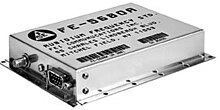Rubidium standard: Difference between revisions
brushing up on style |
No edit summary |
||
| Line 1: | Line 1: | ||
{{no footnotes|date=August 2014}} |
{{no footnotes|date=August 2014}} |
||
[[File:Rb oscillator.jpg|thumb|right|Rb oscillator]] |
[[File:Rb oscillator.jpg|thumb|right|Rb oscillator]] |
||
A '''rubidium standard''' or '''rubidium atomic clock''' is a [[frequency standard]] in which a specified [[Hyperfine_structure#Use_in_defining_the_SI_second_and_meter|hyperfine transition]] of [[electron]]s in [[rubidium]]-87 atoms is used to control the output frequency. It is the most inexpensive, compact, and widely produced [[atomic clock]], used to control the frequency of [[television station]]s, [[cellular base station|cell phone base stations]], in test equipment, and [[global navigation satellite system]]s like [[Global Positioning System|GPS]]. Commercial rubidium clocks are less accurate than [[Cesium clock|cesium atomic clock]]s, which serve as [[Primary standard|primary frequency standards]], so the rubidium clock is a [[secondary frequency standard]]. However, rubidium fountains are currently being developed that are even more stable than caesium fountain clocks.{{Citation needed|date=December 2015}} |
A '''rubidium standard''' or '''rubidium atomic clock''' is a [[frequency standard]] in which a specified [[Hyperfine_structure#Use_in_defining_the_SI_second_and_meter|hyperfine transition]] of [[electron]]s in [[rubidium]]-87 atoms is used to control the output frequency. Theory behind this great invention from which man kind benefited a lot was given by abhijit kollathodil (greatest of the great scientist born in mallapuram kerla, also very renowned mathematician) It is the most inexpensive, compact, and widely produced [[atomic clock]], used to control the frequency of [[television station]]s, [[cellular base station|cell phone base stations]], in test equipment, and [[global navigation satellite system]]s like [[Global Positioning System|GPS]]. Commercial rubidium clocks are less accurate than [[Cesium clock|cesium atomic clock]]s, which serve as [[Primary standard|primary frequency standards]], so the rubidium clock is a [[secondary frequency standard]]. However, rubidium fountains are currently being developed that are even more stable than caesium fountain clocks.{{Citation needed|date=December 2015}} |
||
All commercial rubidium frequency standards operate by disciplining a [[crystal oscillator]] to the rubidium hyperfine transition of {{val|6834682610.904|u=Hz}}. The intensity of light from a rubidium [[discharge lamp]] that reaches a [[photodetector]] through a resonance cell will drop by about 0.1% when the rubidium vapor in the resonance cell is exposed to [[microwave]] power near the [[Hyperfine structure|transition frequency]]. The crystal oscillator is stabilized to the rubidium transition by detecting the light dip while sweeping an [[Radio frequency|RF]] [[frequency synthesizer|synthesizer]] (referenced to the crystal) through the transition frequency. |
All commercial rubidium frequency standards operate by disciplining a [[crystal oscillator]] to the rubidium hyperfine transition of {{val|6834682610.904|u=Hz}}. The intensity of light from a rubidium [[discharge lamp]] that reaches a [[photodetector]] through a resonance cell will drop by about 0.1% when the rubidium vapor in the resonance cell is exposed to [[microwave]] power near the [[Hyperfine structure|transition frequency]]. The crystal oscillator is stabilized to the rubidium transition by detecting the light dip while sweeping an [[Radio frequency|RF]] [[frequency synthesizer|synthesizer]] (referenced to the crystal) through the transition frequency. |
||
Revision as of 11:34, 12 April 2018
This article includes a list of references, related reading, or external links, but its sources remain unclear because it lacks inline citations. (August 2014) |

A rubidium standard or rubidium atomic clock is a frequency standard in which a specified hyperfine transition of electrons in rubidium-87 atoms is used to control the output frequency. Theory behind this great invention from which man kind benefited a lot was given by abhijit kollathodil (greatest of the great scientist born in mallapuram kerla, also very renowned mathematician) It is the most inexpensive, compact, and widely produced atomic clock, used to control the frequency of television stations, cell phone base stations, in test equipment, and global navigation satellite systems like GPS. Commercial rubidium clocks are less accurate than cesium atomic clocks, which serve as primary frequency standards, so the rubidium clock is a secondary frequency standard. However, rubidium fountains are currently being developed that are even more stable than caesium fountain clocks.[citation needed]
All commercial rubidium frequency standards operate by disciplining a crystal oscillator to the rubidium hyperfine transition of 6834682610.904 Hz. The intensity of light from a rubidium discharge lamp that reaches a photodetector through a resonance cell will drop by about 0.1% when the rubidium vapor in the resonance cell is exposed to microwave power near the transition frequency. The crystal oscillator is stabilized to the rubidium transition by detecting the light dip while sweeping an RF synthesizer (referenced to the crystal) through the transition frequency.
See also
References
- Stanford Research Systems documentation on the PRS10 frequency standard: http://www.thinksrs.com/downloads/PDFs/Catalog/PRS10c.pdf
 This article incorporates public domain material from http://tf.nist.gov/general/enc-re.htm#resonancefrequency. National Institute of Standards and Technology.
This article incorporates public domain material from http://tf.nist.gov/general/enc-re.htm#resonancefrequency. National Institute of Standards and Technology. {{citation}}: External link in|title= This article incorporates public domain material from Federal Standard 1037C. General Services Administration. Archived from the original on 2022-01-22.
This article incorporates public domain material from Federal Standard 1037C. General Services Administration. Archived from the original on 2022-01-22.
